Brad nailers are for finishing touches, as opposed to the finish nailers which do the real trim carpentry work.
What does Gauge number mean?
If you can fit 15 nails side-by-side in one inch, they are 15 ‘gauge’.
Easy.
I found no other website with this info! Old school. “Gauge” these days is just a word to most people. See my video on gauge at the very bottom.
Our view: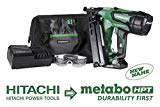
Most shops will end up with at least 2 or 3 guns.
- brad nailer will not tear delicate material
- finish nailer to penetrate trim wood and hard materials.
If you have to pick one first…choose this nail gun. There are pneumatics and less expensive electrics below.
Which One? Brad Nailer vs Finish Nailer?
As Dirty Harry said, “You have to ask yourself one question.”
The One Question: What will you do the most?
The main difference: Brads are smaller ‘gauge’ nails, with smaller heads (like the head of me, bradthepainter). Size matters, Brad.
- Trim nails are 14-, 15-, or 16-gauge
- Brads are usually 18
- Brad nailers are used for finishing touches. For bigger projects, go with a finish nailer.
Most guns can shoot in two modes: sequential and bump mode…Read our posts on the nailers if you don’t know what this is.
1. BRAD NAILERS GIVE YOU…
- Available nail lengths: 5/8 to 2½ inches. (Different gun specs might be different).
- Diameter nails: A brad nail gun shoots 18 gauge nails (smaller than finish nails).
- Price: Brad nailers are more in demand so the competition drives down the price. There are quality guns and budget guns (See my review of brad nailers for different budgets).
- Qualities: Brads are thinner spikes so the holes are tiny and are often left unfilled.
- Versatility: Some brad nailers often accommodate staples, unlike finish nailers. No brad nailers that we know of comes with an angled magazine, ( but it’s not really essential for small projects).
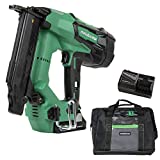
Metabo used to be called Hitachi. Japan sold it back to Germany.
Key: no splits when dealing with delicate materials.
- CONS: brads won’t penetrate thick plywood or even medium density fiberboard, MDF.
You can check here Brad’s brad gun—an amazing tool.
Uses: For finishing touches (more than for holding power)

- Small crafts like picture frames, birdhouses, toys for children
- Narrow trim and molding, paneling, jewelry boxes, or attaching decorative trim and edges to cabinetry.
- Doorstops (not door frames)
- Hold while the glue dries
Hammering brads are hard to insert manually, but not with a brad nail gun.
If you have used a hand-stapler, you can handle an 18 gauge brad nailer.
Small jobs: brad nailer vs. finish nailer the winner is brad nailer.
2. FINISH NAILERS GIVE YOU…
- Available nail lengths: 1 to 2½ inches long, (different gun specs might be different).
- Diameter nails: Finishing nail guns shoot trim nails of 14-, 15-, and 16-gauge.
- Price: Finish nailers of all kinds are about 30% costly more than brad nailers in general, but as we’ll see, they can do a lot more.
- Qualities: Can attach substantial woodwork—create a permanent hold.
- Versatility: Big plus: you can use a finishing nailer with a larger range of materials.

Uses: On any project where you need structural integrity, not just appearance. Strong enough to penetrate thick plywood or even cabinet grade medium density fiberboard, MDF.
- Some cabinetry pieces
- Chair rails
- Wainscoting
- Door casings
- Baseboards
- Trim work (window frames, etc)
- Wide crown molding
- Nails are more difficult to remove with pliers than brads
Trim/finish nailer holes are bigger, so you need to fill them with putty or spackle.
Stainable or pre-colored putty is all covered in our Nailer Accessories post.
Limits: You won’t be able to hold studs together, and small decorative trim might split.
Medium-sized jobs: Brad nailer vs. finish nailer, the winner is finish nailer.
More to know…
Not sure if you want electric or pneumatic? Skip to the next section, just below.
If you’ve decided on pneumatic or electric, your work here is done:
We have 5 posts on nail guns and accessories: you can tell I love them. I picked only top brands that you’ll put in your Will. We have…
- A whole post just on top quality brad nailers
- Review of finish nailers: surprisingly affordable
- The top big boy toys: comparison of framing nailers
- Smallest of all: a review of pin nailers (23 gauge)
- Nail Setting and Nailer Accessories
Electric or Pneumatic? (Last Question)
There are some miscellaneous types (gas, etc) at the bottom, but most folks use either air or electric. (Most woodworkers are switching to electric these days even if they already have a compressor for other pneumatic tools.)
Go electric:
- Electrics are pricey, but good ones are tools you leave your grandchildren. (see our list of the top finish nailers).
- Obviously, pneumatic nailers need an air compressor to work. So add the cost of the air compressor to the bill—a one-time cost divided over all your tools.
- No cord: working on a ladder with an air hose are a drag…literally.
- Battery charging issue with the electric finish nailer and electric brad nailer.
Go pneumatic:
- Pneumatic tools are less expensive if you plan to accumulate the full range of nail guns.
- All of the compressors we listed in our nail gun accessories post can run anything from one pin nailer up to two framing guns.
- Oil: All pneumatics need pneumatic tool oil daily if used all day, and some electrics need a drop now and then.
Honorable Mention
There also exist a few brad and finish nailers of the gas canister type that we did not cover in our nail gun review posts:
- Gas canister finish nailer: cordless and light but you need to buy the propane cans. Popular on many construction sites. A great trim nail gun.
- A gas brad nailer is hard to find…but…If you just found three-hundred bucks in your drawer and don’t know what to do with it, grab the Paslode Gas Canister Brad Nailer. Like a beautiful freak of nature.
VIDEO: This gent has the best video on YouTube about the choice: Brad Nailer vs. Finish Nailer
Opinion: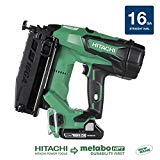
We need both. We just do. Like having different screwdrivers.
But if you have to pick one first…16 is the sweet spot.
A 16 gauge finish nailer, in our view, is the one to have if you just have to have one.
Read my survey of some quality finish nailers.
Great gift for the woodworker in your life: accessories: nail gun accessories page
The results of a poll
I asked some woodworkers, carpenters, and handy-folks, what they would recommend to someone looking to buy only one gun:
a brad nailer vs. finish nailer?
The unanimous result:
- brad nailer vs. finish nailer for the homeowner…………… Finish Nailer
- For the amateur woodworker……………………………………… Brad nailer
- brad nailer or finish nailer for the professional woodworker…………….. Both
- brad nailer vs. finish nailer as a gift to any of the above……………………. Brad nailer
Beginner’s Corner:
Using a brad nailer or finish nailer safely is really important.
Good maintenance and safety practices are the main things people forget.
I still get asked “what is a brad nail?”, and ‘how to use a brad nailer’.
Anyway, the brad is not special: just a simple 18 gauge nail you can disappear in wood. A brad gun makes it easy: brads are hard to work with by hand. One key thing is to practice looking at the wood grain. If you shoot across the grain, do you get splitting? What if you shoot into the end of the board?
Want to know how they work? Bingo. (how stuff works website)
The Ultra Low-Cost Alternative:
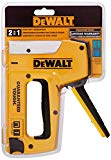 Want to keep it simple? Just buy a combination gun: brad-nailer/stapler.
Want to keep it simple? Just buy a combination gun: brad-nailer/stapler.
Looks just like a staple gun…shoots crown staples like a staple gun but also shoots brads of various lengths.
The only downside is that the power comes only from your muscle (a good thing if you like simplicity) so your hand will get tired if you are doing a lot. I review this baby in this video.
I love my Dewalt…Stamped right on the gun is a list of even other makers’ brad/staple model numbers for a refill. Confident much? Cool move, Dewalt.
Summary: the difference between brad nailer and finish nailer features.
We were asked to answer some questions: ‘what is a brad nail? What size nails for baseboard trim? What can a 16 gauge finish nailer do? What can the 18 gauge brad nail hold?’
That is our look at the battle between the Finish Nailer vs. Brad Nailer. Did we miss anything? Can you tell anyone what is a brad nailer now? We hope you like our look at the basic differences between the 18 gauge brad nail vs. the 16 gauge finish nailer. It comes down to the actual power of the brad nail vs finish nail.
The 18 gauge nail gun is not the nail gun for trim, but the trim nailer, a.k.a. finishing nailer (no difference between a ‘finishing nail gun’ and a ‘trim nailer gun’) is the best choice for any job up to framing a wall and bigger than a bread box!
Note: The US government has a pdf on Nail Gun Safety: excellent; 20pp.
Safety tip: these guns are dangerous (37,000 emergency room accidents per year in the USA). Many makers of nail guns even provide safety glasses with the tool. Just covering their donkey? Yes, but it tells you something. It’s not the wood flying out of the hole you are worried about. It’s the nail. Think about it.
Let us know in the comments what you like better between finish nailers vs brad nailers. Thanks!
Two videos: this one is on my old power stapler, and shown below is about nail gauges. Enjoy your guns.
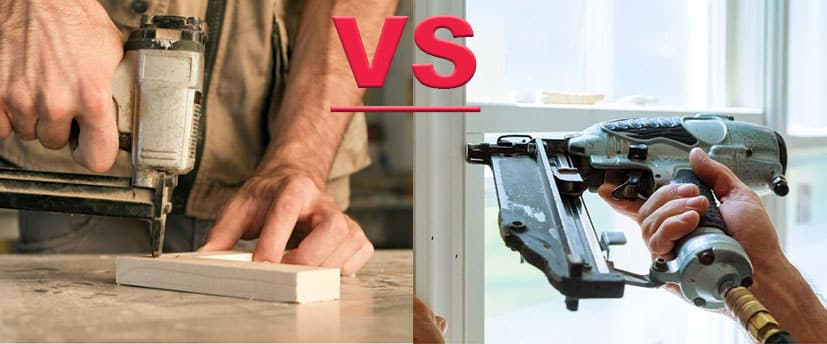
There is available a framing and finish air nailer combo is that feasible or should I stay with a 16 ga nailer ?
They just don’t make them. But you cannot frame with 16. The best way is to do what the builders do… buy one of each. Go with Metabo-Hitachi. You’ll never have problems.